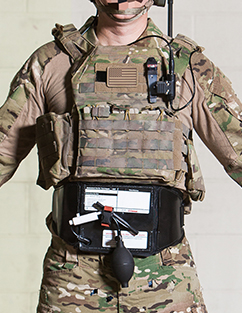Senior Completion Engineer
The Situation
The Charles River Analytics Solution
Charles River Analytics is developing the Tourniquet Master Training (TMT) system to teach, assess, and provide refresher training on this new tourniquet technology. TMT is a scenario-based training system that allows trainees to practice using tourniquets such as the Sam Junctional Tourniquet (SJT) or the Abdominal Aortic Junctional Tourniquet™ (AAJT) (see photo). TMT includes a sensor-system linked to a software-based virtual mentor that provides automatic, objective assessment and feedback during training. A mobile application provides refresher training during deployment or when a manikin is not available for practice. TMT works with multiple types of manikins and adapts to future tourniquet technology advances.
The Abdominal Aortic Junctional Tourniquet™ (Photo courtesy of Compression Works)

Charles River Analytics demonstrating the TMT system at the TATRC open house
This material is based upon work supported by the United States Army Medical Research and Materiel Command under Contract No. W81XWH-13-C-0021. Any opinions, findings and conclusions or recommendations expressed in this material are those of the author(s) and do not necessarily reflect the views of the United States Army Medical Research and Materiel Command.